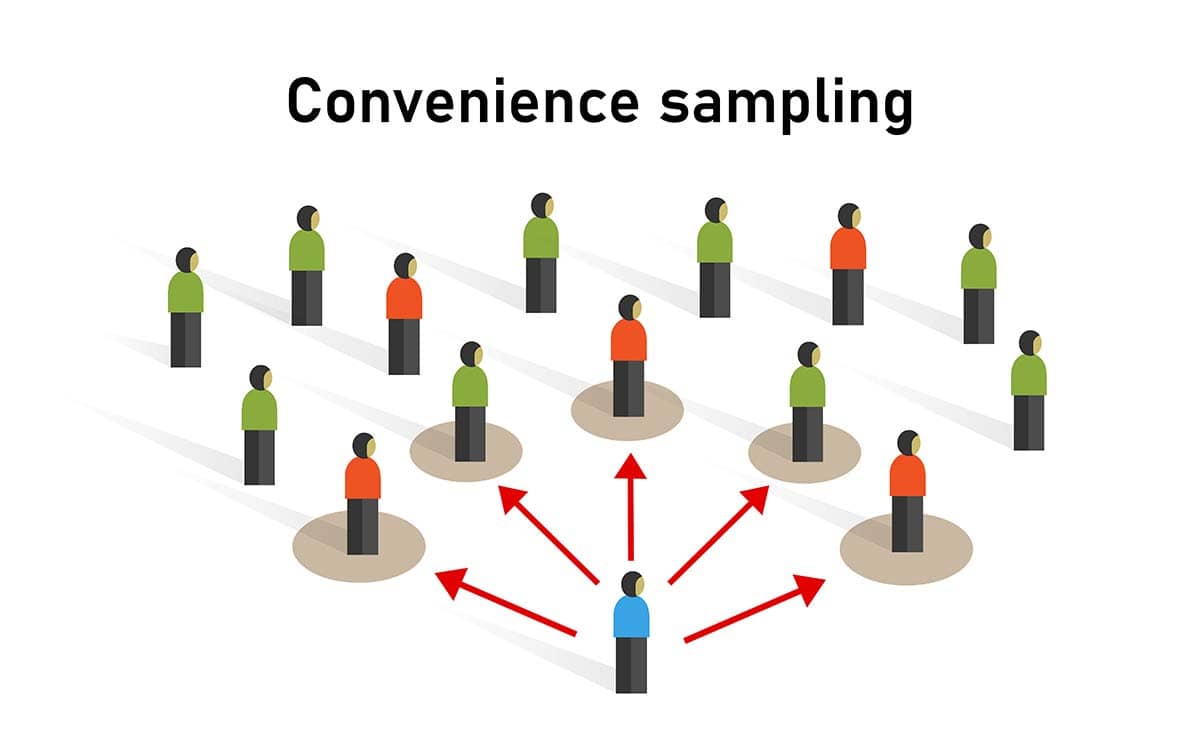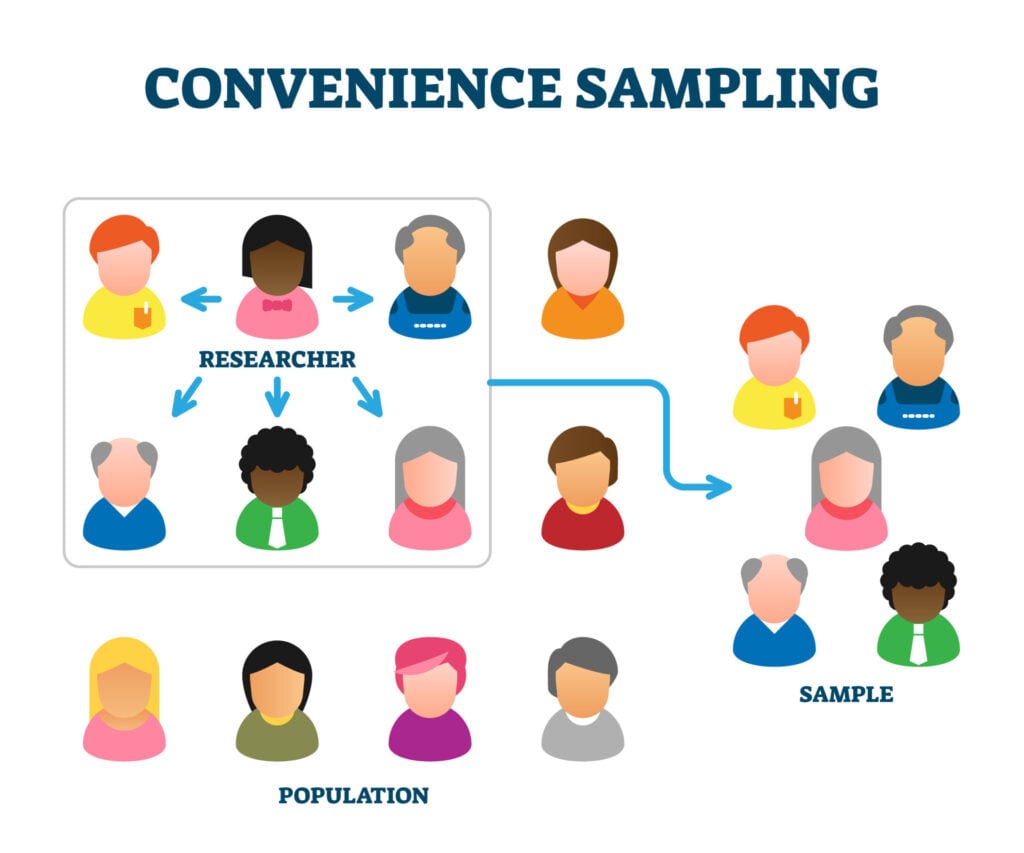On This Page:
Convenience sampling is a non-probability sampling method where data is collected from an easily accessible and available group of people. The individuals in the sample are selected not because they are most representative of the entire population, but because they are most easily accessible to the researcher.
Non-probability sampling means that researchers choose the sample instead of randomly selecting it, so not all population members have an equal chance of participating in the study.

Convenience Sampling Technique
There is little judgment or speculation when choosing the representative sample in convenience sampling; the sole selection criterion is the ease of obtaining a participant.
This can depend on costs, geographic distributions, or the facility of obtaining data. Some examples of convenience sampling could include recruiting friends to participate in your study, collecting data from nearby locations, sending a survey in the mail, or sharing a link on social media.
In convenience sampling, the researcher might choose participants because of their physical proximity, their availability at a given time, or their willingness to participate.
For example, a researcher might survey individuals in a local shopping mall, or students in a university lecture, or individuals on a busy city street.
For example, if high school students are conducting a study on the average pizza consumption in the cafeteria each week, they could call their classmates and ask how many slices they consume during the week.
When To Use Convenience Sampling
Convenience sampling can be useful in specific circumstances:
-
Preliminary or Exploratory Research: Convenience sampling can be a good starting point when conducting initial or exploratory studies. It allows you to gather preliminary data and insights quickly and efficiently, which can be useful in informing more rigorous, probability sampling later.
-
Resource Constraints: When there are constraints in terms of time, budget, or manpower, convenience sampling can provide a low-cost method to collect data.
-
Accessibility Challenges: When a population is hard to access or a sampling frame is unavailable, convenience sampling may be the only feasible way to collect data.
-
Research Generalizability is not the Primary Goal: If the goal of your research is not to generalize the findings to a larger population but to gain deep insights, test instruments, or understand a new phenomenon, convenience sampling can be used.
-
Pilot Testing: Before launching a full-scale research study, a pilot study using convenience sampling might be conducted to test the procedures, measures, and protocols that have been designed for data collection.
How to Use
- Understanding who is the target population that will help your research and plans out where you could go to speak to these people.
- Taking multiple samples as a larger sample size will reduce the chance of sampling error.
- Include both qualitative and quantitative questions in your survey or questionnaire.
- Repeat the survey to ensure the accuracy of your results.
- Use convenience sampling along with probability sampling to supplement your research.
Advantages
Quick, uncomplicated method of data collection
Convenience sampling is beneficial when time is a constraint, as it is a simple method and takes minimal effort.
Many researchers prefer convenience sampling as there are few rules to follow, allowing researchers to generate large samples in short time periods.
Inexpensive
Convenience sampling has little cost involved as no travel, or extensive planning is necessary. This method is particularly useful for students who are on a budget, as it requires minimal cost and experience.
Readily available sample
Convenience sampling tends to be collected with populations that are easily attainable.
As the data is readily available, researchers can use convenience sampling to conduct pilot data or explore a hypothesis that might be tested in future research.
And, if more participants need to be added later, researchers can effortlessly create more samples.
Limitations
Convience Bias
Convenience bias, or selection bias, can occur when researchers use convenience sampling for their study.
Bias is the primary disadvantage of convenience sampling; in some cases, this sole limitation can outweigh the advantages. Collected samples may not represent the population of interest; thus, the results cannot be generalized to a greater population.
Some examples of the types of bias that could result from convenience sampling include sampling bias, selection bias, and positivity bias.
Low external validity
Due to the high probability of bias in convenience sampling, your research findings will likely have little credibility in the greater research industry.
Examples
- Collect symptom profiles of patients with COVID-19 (Burke et al., 2020).
- Estimate immunity to vaccine-preventable diseases in children in Victoria, Australia (Kelly et al., 2002).
- Examine the physical, mental, and cognitive functions of centenarians (Richmond et al., 2011).
- Study eating disorder symptoms and weight and shape concerns of women ages 50 and above (Gagne et al., 2012).
- Examine JUUL use patterns, other tobacco product use, and reasons for use among users (Leavens et al., 2019).
- Characterize patterns of caffeine consumption among U.S. college students (Norton, Lazev, & Sullivan, 2011).
- Evaluate at-risk and problem gambling among adolescents (Castren et al., 2015).
Further Information
- Sampling Methods
- Quota Sampling
- Snowball Sampling
- Stratton, S. J. (2021). Population research: convenience sampling strategies. Prehospital and disaster Medicine, 36(4), 373-374.
- Etikan, I., Musa, S. A., & Alkassim, R. S. (2016). Comparison of convenience sampling and purposive sampling. American journal of theoretical and applied statistics, 5(1), 1-4.
- Sedgwick, P. (2013). Convenience sampling. Bmj, 347.

1. Why use convenience sampling in quantitative research
Convenience sampling is often used for qualitative research. Researchers use this sampling technique to recruit participants who are convenient and easily accessible.
For example, if a company wants to gather feedback on its new product, it could go to the local mall and approach individuals to ask for their opinion on the product.
They could have people participate in a short survey and ask questions such as ‘have you heard of x brand?’ or ‘what do you think of x product?
2. Why is convenience sampling biased?
Because researchers usually cannot generalize the survey results to the population as a whole, the estimates derived from convenience samples are often biased.
There is the possibility of over or under-representation as the sample poorly represents the target population. Since subjects are selected because they are easily accessible, researchers tend not to gain a range of participants each time they collect data.
They also may exclude relevant demographic subsets from the results.
3. How to reduce bias in convenience sampling?
There are many strategies that researchers can use to reduce bias when convenience sampling. One of the most successful ways to reduce bias is using convenience and probability sampling.
Probability sampling uses a random selection process, so everyone in your population has an equal chance of being chosen. Using convenience and probability sampling together will enable researchers to draw accurate conclusions by reducing or eliminating bias.
Other techniques to effectively convenience samples include:
1. Taking multiple samples as a larger sample size will reduce the chance of sampling error;
2. Repeat the survey to ensure the accuracy of your results;1.
3. Including both qualitative and quantitative questions in your survey or questionnaire;
4. Taking multiple samples as a larger sample size will reduce the chance of sampling error.
4. What is the difference between convenience and purposive sampling?
Purposive sampling and convenience sampling are often used interchangeably, but they are two different methods. Researchers in convenience sampling will recruit participants based solely on convenience and accessibility.
They will leverage individuals that can be accessed with minimal effort. On the other hand, researchers in purposive sampling will use judgment and planning to select a sample of individuals that will benefit their study.
Researchers must have prior knowledge about the purpose of the study so they can choose participants that will fit certain characteristics and represent the greater population of interest.
5. Describe the difference between convenience sampling and quota sampling.
Convenience sampling and quota sampling are both types of non-probability sampling methods used in research, but they differ in selecting participants.
Convenience sampling involves collecting data from individuals who are readily available and convenient to access. There’s no attempt to make the sample representative of the larger population.
Quota sampling involves identifying subgroups in the population and setting quotas for individuals to be included in the sample from each subgroup. The subgroups can be based on characteristics such as age, gender, race, etc. The aim is to make the sample more representative of the population.
6. What is availability sampling?
Availability sampling, or convenience sampling, is a non-probability sampling method where participants are chosen based on their availability and readiness to participate in a study. In this sampling approach, the researcher selects participants because they are convenient and easily accessible rather than ensuring that the sample is representative of the entire population.
Key Terms
- A sample is the participants you select from a target population (the group you are interested in) to make generalizations about. As an entire population tends to be too large to work with, a smaller group of participants must act as a representative sample.
- Representative means the extent to which a sample mirrors a researcher’s target population and reflects its characteristics (e.g., gender, ethnicity, socioeconomic level). In an attempt to select a representative sample and avoid sampling bias (the over-representation of one category of participant in the sample), psychologists utilize various sampling methods.
- Generalisability means the extent to which their findings can be applied to the larger population of which their sample was a part.
References
Burke, R. M., Killerby, M. E., Newton, S., Ashworth, C. E., Berns, A. L., Brennan, S., … & Case Investigation Form Working Group. (2020). Symptom profiles of a convenience sample of patients with COVID-19—United States, January–April 2020. Morbidity and Mortality Weekly Report, 69(28), 904.
Castrén, S., Grainger, M., Lahti, T., Alho, H., & Salonen, A. H. (2015). At-risk and problem gambling among adolescents: a convenience sample of first-year junior high school students in Finland. Substance abuse treatment, prevention, and policy, 10(1), 1-10.
Convenience sampling: Definition, advantages and examples. QuestionPro. (2021). Retrieved from https://www.questionpro.com/blog/convenience-sampling/
Convenience sampling method: How and when to use it? Qualtrics. (2021). Retrieved from https://www.qualtrics.com/experience-management/research/convenience-sampling/
Gagne, D. A., Von Holle, A., Brownley, K. A., Runfola, C. D., Hofmeier, S., Branch, K. E., & Bulik, C. M. (2012). Eating disorder symptoms and weight and shape concerns in a large web‐based convenience sample of women ages 50 and above: Results of the gender and body image (GABI) study. International Journal of Eating Disorders, 45(7), 832-844.
Kelly, H., Riddell, M. A., Gidding, H. F., Nolan, T., & Gilbert, G. L. (2002). A random cluster survey and a convenience sample give comparable estimates of immunity to vaccine preventable diseases in children of school age in Victoria, Australia. Vaccine, 20(25-26), 3130-3136.
Lavrakas, P. J. (2008). Encyclopedia of survey research methods (Vols. 1-0). Thousand Oaks, CA: Sage Publications, Inc. doi: 10.4135/9781412963947
Leavens, E. L., Stevens, E. M., Brett, E. I., Hébert, E. T., Villanti, A. C., Pearson, J. L., & Wagener, T. L. (2019). JUUL electronic cigarette use patterns, other tobacco product use, and reasons for use among ever users: results from a convenience sample. Addictive behaviors, 95, 178-183
Norton, T. R., Lazev, A. B., & Sullivan, M. J. (2011). The “buzz” on caffeine: Patterns of caffeine use in a convenience sample of college students. Journal of caffeine research, 1(1), 35-40.
Richmond, R. L., Law, J., & Kay‐Lambkin, F. (2011). Physical, mental, and cognitive function in a convenience sample of centenarians in Australia. Journal of the American Geriatrics Society, 59(6), 1080-1086.

